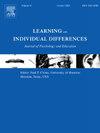从教育文本中学习:随着结构构建技能的提高,整体文本衔接的减少是否是一种可取的困难?
IF 3.8
1区 心理学
Q1 PSYCHOLOGY, EDUCATIONAL
引用次数: 0
摘要
提高从课文中学习的一种可能性是在课文中引入“理想的困难”。为此,我们操纵了教科书章节的整体衔接,并检验了结构构建技能的个体差异与整体衔接水平相互作用的可能性。这种相互作用(没有考虑到工作记忆容量)是显著的:那些结构构建技能较低的人在阅读低衔接(困难)的文本后,在教育真实的理解问题上表现较差,相对于高衔接的文本。对于更熟练的结构构建者,在文本衔接水平上的理解是相似的;然而,对于更熟练的结构构建者来说,低衔接文本并没有产生更好的理解。更熟练的结构构建者似乎更擅长在所呈现的信息之间建立关系,从而在全局层面上准确地捕捉子主题和思想之间的相互联系,即使对于凝聚力较弱的文本也是如此。支持这一观点的是,随着结构构建技能的提高,学习者生成的表征与专家的结构更加紧密地联系在一起。教育的相关性和意义为了促进从文本中学习,教育方面的标准建议是构建一个有凝聚力的文本,帮助读者理解文本中所呈现的概念和思想之间的相互联系(而不是作为事实列表)。基础理论和研究提出的另一种具有挑衅性的观点是,在某些情况下,文本的凝聚力较低的版本可以通过促使读者更积极地参与文本来促进学习。本研究通过去除旨在帮助读者理解的文本信号(主题标题、粗体术语和“带回家”文本框),降低了教科书章节的整体衔接。我们发现,这些文本信号的存在或不存在并不影响相对熟练地构建对所读内容的连贯理解的读者的学习表现。相比之下,缺乏这些文本信号会损害那些不太擅长构建连贯理解的读者的学习表现。这强烈暗示着,对于那些努力形成对阅读作业连贯理解的学生来说,教科书提供明确的信号以促进理解尤为重要。本文章由计算机程序翻译,如有差异,请以英文原文为准。
Learning from educational texts: is reduction in global text cohesion a desirable difficulty as structure building skill increases?
One possibility for improving learning from text is to introduce “desirable difficulties” into the text. To do so, we manipulated the global cohesion of a textbook chapter and examined the possibility that individual differences in structure-building skill would interact with level of global cohesion. The interaction (not accounted for by working memory capacity) was significant: Those with lower structure-building skill performed poorly on educationally authentic comprehension questions after reading a low-cohesion (difficult) text, relative to a high-cohesion text. For more-skilled structure builders, comprehension was similar across text-cohesion levels; however, the low-cohesion text did not produce better comprehension for more-skilled structure builders. More-skilled structure builders appear adept at building relations across presented information, thereby accurately capturing interconnections among subtopics and ideas at a global level, even for texts that are less cohesive. Supporting this notion, the representations generated by learners became more closely aligned with experts' structures as structure-building skill increased.
Educational relevance and implications
To facilitate learning from texts, a standard recommendation in education is to construct a cohesive text that helps readers understand the interconnections among the concepts and ideas presented in the text (rather than as a list of facts). A provocative alternative suggested by basic theory and research is that in some cases a less cohesive version of the text can improve learning by prompting readers to more actively engage with the text. The present study decreased the global cohesion of a textbook chapter by removing the text signals (topic headers, bolded terms, and “take-home” text boxes) intended to assist the reader in understanding. We found that the presence/absence of these text signals did not affect the learning performance of readers who were relatively skilled in constructing a coherent understanding of things they read. By contrast, the absence of these text signals impaired the learning performance of readers who were less skilled at constructing a coherent understanding. The strong implication is that for students who struggle to form a coherent understanding of their reading assignments, it is especially important for textbooks to provide explicit signals that facilitate understanding.
求助全文
通过发布文献求助,成功后即可免费获取论文全文。
去求助
来源期刊

Learning and Individual Differences
PSYCHOLOGY, EDUCATIONAL-
CiteScore
6.60
自引率
2.80%
发文量
86
期刊介绍:
Learning and Individual Differences is a research journal devoted to publishing articles of individual differences as they relate to learning within an educational context. The Journal focuses on original empirical studies of high theoretical and methodological rigor that that make a substantial scientific contribution. Learning and Individual Differences publishes original research. Manuscripts should be no longer than 7500 words of primary text (not including tables, figures, references).
 求助内容:
求助内容: 应助结果提醒方式:
应助结果提醒方式:


